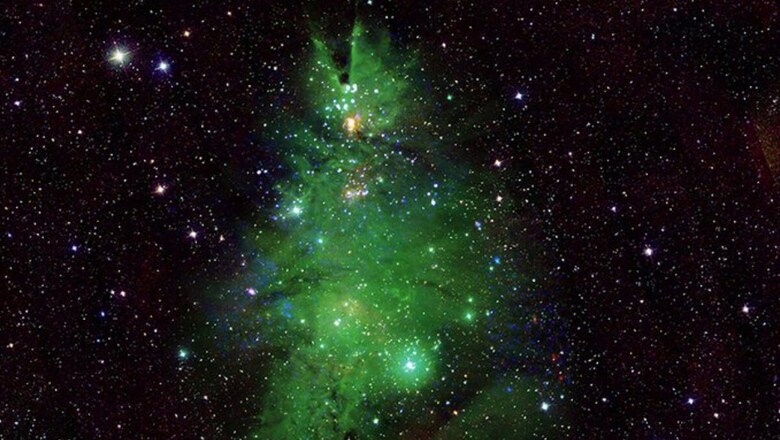
views
Picture a Christmas tree not adorned with blinking bulbs and knotted wires, but instead aglow with the vivid brilliance of young stars. This festive season, the National Aeronautics and Space Administration (NASA) has gifted us a spectacular cosmic display featuring the stellar nursery NGC 2264, known as the Christmas Tree Cluster. In a celestial twist, this captivating image reveals a stunning resemblance to a Christmas tree, with a bright green glow and sparkling blue and white lights.
The announcement of this extraordinary celestial display comes from NASA’s Chandra X-ray Observatory, capturing the essence of the holiday season with a whimsical tweet: “It’s beginning to look a lot like cosmos. Our ChandraXray Observatory recently spotted the blue-and-white lights that decorate the ‘Christmas Tree Cluster,’ a swarm of stars and gas some 2,500 light-years from Earth.”
It’s beginning to look a lot like cosmos.Our @ChandraXray Observatory recently spotted the blue-and-white lights that decorate the “Christmas Tree Cluster,” a swarm of stars and gas some 2,500 light-years from Earth: https://t.co/VT2WaLgp77 pic.twitter.com/HrnrmxRyd7
— NASA (@NASA) December 19, 2023
NGC 2264 is a cluster of young stars situated in our Milky Way, approximately 2,500 light-years away from Earth. These celestial wonders boast ages ranging from one to five million years old, encompassing stars both smaller and larger than our Sun.
The composite image crafted by NASA turns NGC 2264 into a cosmic holiday spectacle, with the green glow representing gas and the blue and white sparkles signifying young stars emitting X-rays, says NASA.
Utilizing optical data from the National Science Foundation’s WIYN 0.9-meter telescope on Kitt Peak, the image unveils the presence of green gas in the nebula, resembling the pine needles of a tree. NASA further explained that infrared data from the Two Micron All Sky Survey highlights foreground and background stars in white.
The image underwent a clockwise rotation of approximately 160 degrees, departing from the standard orientation of astronomers. This unconventional adjustment creates the illusion of the tree’s apex aligning with the upper edge of the image.
Young stars, akin to those forming NGC 2264, are recognised for their volatility, showcasing robust flares in X-rays and exhibiting diverse variations across different light spectra.
The coordinated blinking variations seen in the animation, however, are artificial, strategically applied to accentuate the X-ray-emitting stars’ positions and underscore the Christmas tree resemblance. In reality, the stars’ variations are not synchronised, NASA added.



















Comments
0 comment